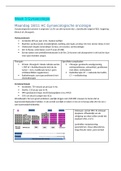Week 3 Gynaecologie
Maandag 18/11 HC Gynaecologische oncologie
Gynaecologische tumoren is ongeveer 12,5% van alle tumoren bij v. classificatie volgens FIGO. Stagering:
klinisch of chirurgisch.
Vulvacarcinoom
Incidentie 387 per jaar in NL. Oudere leeftijd.
Klachten: puritus (jeuk), branderigheid, zwelling, pijn (laat), pt delay 10 mnd, doctor delay 3 mnd
Onderzoek: biopsie (stransbiopt 1e keus, evt excisie), cervixcytologie
AO: X-thorax, echo liezen, (evt CT-scan of MRI)
Eerste station van lymfekliermetastasen is de lies. Ze kunnen ook doorgroeien in de huid en daar
voor open wonden zorgen.
Therapie: Specifieke complicaties
Primair chirurgisch: lokale radicale excisie Chirurgie: gestoorde wondgenezing,
+ SNP of + liesklierdissectie bdz (als de mictieproblemen, seksualiteit, problemen
tumor > 4cm, multifocale tumor, geen met zitten, lymfoedeem
schildwachtklier opgekomen) Radiotherapie: KT -> nattende dermatitis,
Radiotherapie, soms gecombineerd met LT -> verlittekening
chemotherapie
Cervixcarcinoom
Incidentie: 759 nieuwe pt per jaar in NL
Sterfte: 215 pt per jaar in NL
HPV-gerelateerd (type 16,18 (belangrijkste circa 70%))
55% van de pt is jonger dan 50 jr.
Wereldwijd is het een groot probleem: jaarlijks krijgen ruim 500.000 vrouwen te horen dat ze
baarmoederhalskanker hebben. In de wereld overlijdt er iedere 2 min en in Europa elke 20 min een v
aan baarmoederhalskanker.
Ontstaan: via het HPV. Er ontstaat
dysplasie. Afhankelijk van de
uitrijping van deze cellen wordt het
stadium CIN1, 2 of 3.
Lymfeklier metastasering:
parametrium, fossa obturatorius,
langs iliacale vaten, para-aortaal
,Symptomen:
Symptomen lage stadia: abnormaal bloedverlies, fluorklachten, contactbloedingen
Symptomen hoge stadia: symptomen lage stadia, mictie/deficatieklachten, pijn in de
rug/flank/onderbuik/been, lymfoedeem
Diagnose:
Afwijkende uitstrijk/portio; colposcopie; biopt voor pathologie
Onderzoek in narcose bij hoog stadium (klinisch stadium) - cystoscopie
Disseminatie onderzoek: lab, X-thorax, MRI (PET)
Therapie:
Operatie Radiotherapie/chemoradiatie
Conisatie (laagste stadium) Chemoradiatie
Thrachelectomie (baarmoedersparend) Radiotherapie + hyperthermie
Radicale hysterectomie + pelviene Image Modulated Radiotherapy (IMRT)
lymfadenectoie Brachytherapie (MRI-geleid)
Excenteratie (bij recidief) Neo-adjuvante chemotherapie
Laag stadium Hoog stadium
FIGO-stadium IA-2, IBI, kleine IIA FIGO-stadium IB2, bulky 2A en 2B – IVA
o Beperkt tot de cervix en kleiner Therapie:
dan 4 cm o Standaard = chemotherapie
o Beperkt tot de proximale vagina (relatief lage dosering
Therapie o Optioneel
o Standaard = radicale Radiotherapie +
hysterectomie + pelviene hyperthermie
lymfadenectomie bdz Neo-adjuvante
o Optioneel chemotherapie
Trachelectomie + Alleen radiotherapie
laparoscopische pelviene Palliatieve therapie
lymfadenectomie
(tumoren <2cm en Chemoradiatie:
kinderwens) Sinds 2000 standaardbehandeling
Radiotherapie of Stadium IB-2 > 4cm en hoger
chemotherapie Radiotherapie dagelijks gedurende 6 wk
o 2x24 uur brachytherapie
Adjuvante therapie na primaire chirurgie: (inwendige bestraling)
Indicatie: krappe snijranden, ingroei Chemotherapie 1x per week cisplatin (in
parametrium, positieve lymfeklieren dagbehandeling)
Therapie adjuvant: standaard = o Chemotherapie werkt als
radiotherapie; optioneel chemotherapie ‘sensibilisator’
(bij prognostische ongunstige therapie)
Complicaties chemoradiatie:
Complicaties chirurgie cervixcarcinoom: radiatie-enteritis/proctitis, mictiestoornissen,
mictiestoornissen, deficatiestoornissen, stenosering en fibrosering vagina (seksualiteit),
lymfoedeem (10%), hormonale stoornissen, fistelvorming, ovariële dysfunctie.
algemene chirurgische complicaties.
, Ovariumcarcinoom
Incidentie: 1325 per jaar in NL. 10-15% is erfelijk, geassocieerd met de BRCA-1 en 2 genmutaties.
Classificatie ovariumtumoren
Epitheliale tumoren (80%) - carcinomen (inclusief extraovarieel en tuba), borderline tumoren
Niet-epitheliale tumoren (20%) - seks cord-stroma tumoren, kiemceltumoren, metastasen
Epitheliale tumoren
Ontstaan uit coeloomepitheel (ovarium, tuba, peritoneum)
‘Silent killer’ - pas laat klachten, 70% reeds stadium III of hoger
Klachten:
o Laag stadium: vaak geen klachten, toeval solitaire cyste
o Hoog stadium: bolle buik, ascites
Intraperitoneale verspreiding – de ziekte verspreidt zich door de buik en je krijgt een peritonitis
carcinomatosa
Therapie (epitheliale ovariumcarcinoom): vaak een combinatie van chirurgie met chemotherapie
Chirurgie: debulking laparotomie, stadiëring laparotomie/scopie
Interval debulking (na neo-adjuvante chemotherapie)
Systeemtherapie: platinum en paclitaxel (chemotherapie), (bevacizumab), (PARP-inhibitors)
Stadiëringsoperatie ovariumcarcinoom Debulkingsoperatie ovariumcarcinoom
Indicatie: verdenking LAAG-stadium ovariumcarcinoom Doel reduceren van de tumorload
CAVE ‘upstaging’ in 20% van de pt Complete debulking – geen
macroscopische tumorrest
Spoelvocht Optimale debulking - <1 cm3
Uterus + adnex-extirpatie tumorrest
Omentectomie Incomplete debulking – tumorrest
Lymfadenectomie ileacaal bdz >1cm3
Lymfadenectoie para-aortaal Interval debulking – na 3 kuren
Biopten blaaskoepel, Douglas, paracolisch, diafragma chemotherapie
Chemotherapie:
Carboplatine + paclitaxel (iv) - 6 kuren (6x3 wk), ipc in dagbehandeling
Intra-peritoneale chemotherapie: 6x deels iv en deels ip na primaire debulking; hypertherme
intraperitoneale chemotherapie (HIPEC) bij intervaldebulking
Follow-up: standaard ipc zonder laboratorium tumormarker (Ca-125). Tumormarker leidt niet
tot een betere overleving, zorgt wel voor meer onrust bij de pt. Marker is ook niet bij alle
tumoren verhoogd. Iedereen heeft de stof in zijn lichaam.
Bij recidief > 6 mnd – platinum + gemcitabine + PARP-inhibitor
Vaginacarcinoom Zeldzame tumor: 2% van alle gynaecologische tumoren. 64 pt per jaar in NL.
Behandeling: primaire radiotherapie, evt chemoradiatie, evt chirurgie
Familiaire gynaecologische tumoren




